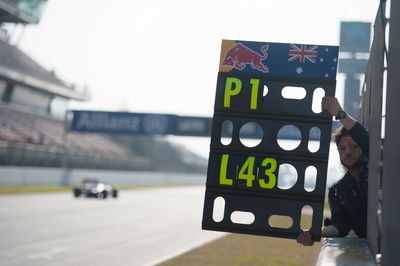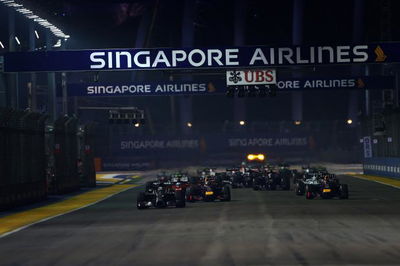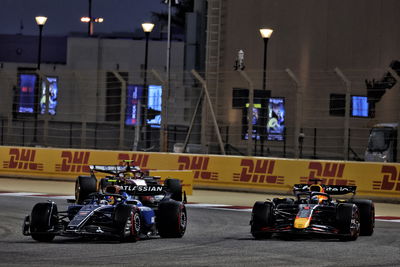FIA sets out driver aid restriction plan for F1 2016

The FIA has detailed its plans to enforce a restriction on driver aids for the 2016 Formula 1 World Championship season, with a particular crackdown on pit-to-driver communication.
Having hinted at the intention to 'place greater focus on the driver' from 2016, the FIA will enforce a number of changes designed to limit the information relayed from the pit lane, as well as some technical restrictions.
Pit-to-driver communications and signalling has received a particular focus, with guidelines of what can be relayed being set out. These are focused on lap times, conditions of the car, race control messages and track information, but excludes messages informing a driver to 'life and coast' or 'fuel save' for instance.
Furthermore, with new start procedures coming into force for the Belgian Grand Prix, the FIA has expanded on this by enforcing a single clutch rule for starts in 2016, the implementation a standard ECU that would inhibit the use of a 'bite point finder' on race day and a limit to telemetry channels.
Full details of these amendments to the sporting regulations are detailed below
A)The following pit-to-driver messages are permitted. Any other message is likely to be considered a breach Article 20.1 of the Sporting Regulations.
- Indication of a critical problem with the car, e.g. puncture warning or damage.
- Indication of a problem with a competitor's car.
- Instruction to enter the pit lane in order to fix or retire the car.
- Marshalling information (yellow flag, red flag, race start aborted or other similar instructions or information from race control).
- Wet track, oil or debris in certain corners.
- Instructions to swap position with other drivers.
- Acknowledgement that a driver message has been heard
- Lap or sector time detail
- Lap time detail of a competitor
- Gaps to a competitor during a practice session or race
- "Push hard", "push now", "you will be racing xx" or similar
- Helping with warning of traffic during a practice session or race
- Giving the gaps between cars in qualifying so as to better position the car for a clear lap
- Tyre choice at the next pit stop
- Number of laps a competitor has done on a set of tyres during a race
- Tyre specification of a competitor
- Information concerning a competitor's likely race strategy
- Safety Car window
- Driving breaches by team driver or competitor, e.g. missing chicanes, running off track, time penalty will be applied etc.
- Notification that DRS is enabled or disabled
- Dealing with a DRS system failure
- Change of front wing position at the next pit stop
- Oil transfer
- When to enter the pits
- Reminders to check for white lines, bollards, weighbridge lights when entering or leaving the pits
- Reminders about track limits
- Passing on messages from race control
- Information concerning damage to the car
- Number of laps remaining
- Test sequence information during practice sessions, e.g. aero-mapping
- Weather information
* These are the only messages that may be passed to the driver, whilst he is in the car and on the track, from the
B) Driver torque demand map freeze when the car is on the track
- Changes to the driver torque demand map will be inhibited when the car is on the track
- The ability for the torque coordinator to change the minimum and maximum lines of the driver torque demand map will be retained to match the power unit operating envelope
- Selection of the throttle pedal shaping map via the tyre switch will be inhibited when the car is on the track
C) Clutch torque control
- Unless a clearly defined fault arises during the start procedure only a single clutch operating device may be used for the start, this will not preclude the fitting of two operating devices but only one may be used for the start itself
- The shape of the clutch operating device to target map will be standardised, or at least restricted in order to enforce a minimum gradient over a defined range
- As an interim measure before introducing a standard clutch in 2017, the possibility of implementing a clutch torque controller will be investigated
- If such a measure proves feasible the entire clutch torque controller would be implemented in the standard SECU software. It would use the signal from the power unit torque sensor or torque model (as a backup)
D) Clutch bite point (stricter enforcement in 2016)
- As enforced starting at the Belgian Grand Prix 2015, the clutch bite point may not be changed from the time the car leaves the garage for the first time after the pit lane is open on the day of the race until the end of the start lockout period after the race has started. For the avoidance of doubt, it will still be permissible to use a manual bite point offset switch for use after the race start lockout period
- The FIA standard ECU will automatically inhibit the use of the bite point finder on the day of the race
E) Limit on number and type of telemetry channels
- Methods to limit the telemetry channels sent in real-time from the car to the pits will be investigated
- The objective will be to restrict real-time data flow to signals essential to run the car. Any 'monitoring' or non-essential channels should only be logged to on-car memory











